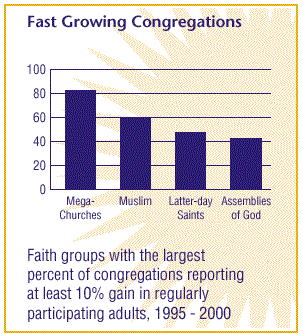A Quick Question
How quickly are Muslim mosques
growing in the U.S.?
The quick answer: At an almost unparalleled rate!
The longer answer: According to the recent Faith Communities Today study (FACT), the membership in Muslim mosques is increasing at a rapid pace, coming in second only to megachurches in the United States.
Mosques trailed megachurches, 83 percent of which grew by ten percent or more in membership from 1995 to 2000 as compared to 60 percent of masjids, the Arabic term for a Muslim congregation, which grew by 10% or more in that same time period. Ten percent or more congregational growth was found in 48 percent of Latter-day Saints congregations, 42 percent of Assemblies of God churches, 29 percent of Roman Catholic and Orthodox congregations, 39 percent of evangelical Protestant congregations, and 27 percent of old-line Protestants.

David Roozen, director of Hartford Institute for Religion Research and co-coordinator of the Faith Communities Today study, credits the growth to several factors. "Immigration of Muslims who are professional people is significant," he says. There is also a growing self-consciousness and self-confidence among American Muslims, according to the Hartford professor. The events since September 11 of this year indicate that American Muslims are eager to be full participants in the mainstream of U.S. cultural and political life, he said.
Roozen noted that there has been considerable debate about the number of Muslims in the United States. "There are credible arguments for both the high and the low ends of the projected Muslim population," he said. "We simply don’t know how many Muslims there are, but the FACT data certainly suggest that Islam is one of the fastest growing religious groups in the United States."
Not only are there more Muslim members in mosques but there are also many more new mosques in the U.S. than a decade ago. According to the FACT survey, the total number of mosques in the United States increased 42 percent between 1990 and 2000. This is a considerable rate of new growth especially when compared with a 12 percent average increase for the study’s evangelical Protestant denominations, and a two percent average increase among old-line Protestant, and Catholic and Orthodox groups.
Dr. Jane I. Smith, co-director of the Duncan Black Macdonald Center for the Study of Islam, also located at Hartford Seminary, pointed out that in the 1980s and 90s mosques and Islamic centers were built with generous contributions from abroad. Now, she says, most are being constructed by American Muslims. "There now are many affluent Muslims in America—individuals with organizational skills and with sufficient financial means to build the mosques and Islamic centers that are now common all across our nation," Roozen noted.
These masjids generally include several national and ethnic groups, according to Professor Ihsan Bagby, of Shaw University in Raleigh, N.C. "Most U.S. masjids are intercultural, and include Muslims from Asia and Africa and Europe as well as from several Arab countries," Dr. Bagby states and points out that a racial or ethnic focus is contrary to Qur’anic teaching.
He reports that 93 percent of all U.S. mosques are attended by more than one ethnic group.
"As a matter of fact," Bagby says, "only about 27 percent of U.S. mosques emphasize an ethnic focus and most of these are located in African American neighborhoods." By contrast, among Christians 64 percent of Latino congregations in the United States and 50 percent of African American congregations place a high priority on preserving their racial, ethnic or national heritage.
Preserving religious culture is deemed more important with 69 percent of mosques providing prayer services five times daily year round and 70 percent providing weekend religious classes.
For further information about the Faith Communities Today study, you can visit the web site at http://fact.hartsem.edu. You can also read the report released by the Council on American-Islamic Relations at http://www.cair-net.org/mosquereport/index.html .
Return to the Quick Question archive
|
